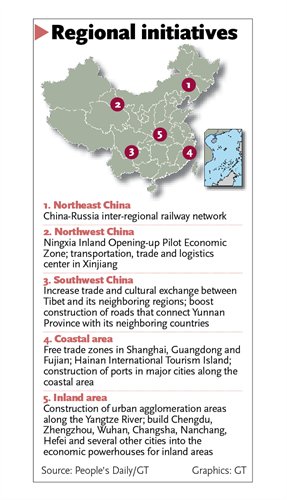

China establishes leading group to oversee initiatives

The Chinese central government has set up a special leading group to oversee the implementation of the "One Belt, One Road" initiatives, the office of the group said in a statement on Sunday, following the release of the principles, framework, priorities and mechanism for the initiatives.
The statement said the leading group will be in charge of guiding and coordinating work related to the initiatives. It did not specify the group members, but said the office is under the National Development and Reform Commission, China's top economic planner.
The blueprint for the China-proposed Silk Road Economic Belt and 21st Century Maritime Silk Road initiatives is set to fuel the Chinese economy, boosting the development of less-developed and inland regions, analysts said.
China on Saturday unveiled the blueprint which called for policy coordination, financial cooperation, infrastructure building and free trade to leverage the comparative advantages of the natural resources in various regions.
The idea, raised by Chinese President Xi Jinpingin 2013, is to lay infrastructure networks to better connect its economy with the rest of Asia, Africa, the Middle East and Europe.
Xi said on Sunday at the Boao Forum for Asia (BFA) that his target for the Belt and Road plan is to increase total trade volume with neighboring countries to over $2.5 trillion in 10 years.
The action plan came three days ahead of Tuesday's deadline of the application to join the Asian Infrastructure Investment Bank, a China-initiated lender which will offer financing for regional infrastructure projects.
Besides efforts to speed up the development of more developed coastal region like the China (Shanghai) Pilot Free Trade Zone, inland regions are poised to become the new focus for the grand plan.
Northwest China's Xinjiang Uyghur Autonomous Region is earmarked to be the core area on the Silk Road Economic Belt as a key transportation, trade and logistics center. It has geographical advantages of being a gateway to Central, South and West Asian countries.
The authorities also pledge to advance the building of the Ningxia Inland Opening-up Pilot Economic Zone as a trade and logistical hub for industrial and cultural exchanges with Central, South and West Asian countries.
Northeastern regions, including Heilongjiang, Jilin and Liaoning provinces, are also open to cooperation with Russia's Far East region on sea-land multi-modal transport.
"The plan will break the current bottleneck in China's economic development as shown in the divide between coastal and inland regions by providing strategic support for the less developed regions," Han Meng, a research fellow of the Institute of Economics of the Chinese Academy of Social Sciences, told the Global Times.
Over the last 30-plus years since the implementation of China's reform and opening-up, inland regions like Xinjiang and Gansu Province have lagged behind in investment because of undeveloped transport systems, Han said.
As China's economy experiences the "new normal" with a slower GDP growth, the Belt and Road initiatives will facilitate China's ongoing economic restructuring in its shift away from low-end production, Han noted.
To expand cooperation, China will negotiate with countries and regions along the Belt and Road routes on opening free trade areas with lower non-tariff barriers. It will also push forward negotiations on bilateral investment protection agreements and double taxation avoidance agreements to protect the lawful rights and interests of investors.
Chen Ji, director of the China Center for the research of Industrial Economics at the Capital University of Economics and Business, told the Global Times that the new plan will further provide stimulus to economic structural reform.
"As China increases economic exchanges with nearby regions, it can tap into more potential markets. Increased trade will also provide a further boost to the free trade zones as part of China's plan for a more market-oriented economy," said Chen.
Speaking at the Boao Forum on Saturday with the Global Times, Xiang Wenbo, president of Sany Heavy Industry Co, the world's sixth-largest heavy equipment manufacturer, said that 70 to 80 percent of the company's products were consumed by countries along the "One Belt, One Road" region. He believes Chinese companies like his will be able to explore bigger a market potential with the initiatives.
The BFA closed on Sunday. The conference was attended by 2,786 political, business and academic leaders as well as journalists from 49 countries and regions.
Liang Fei contributed to this story
 J-11 fighters in air exercise
J-11 fighters in air exercise Beauties dancing on the rings
Beauties dancing on the rings Attendants-to-be join Mr. & Miss Campus Contest
Attendants-to-be join Mr. & Miss Campus Contest Beijing's toughest anti-smoking law takes effect
Beijing's toughest anti-smoking law takes effect Family lives in cave for about 50 years in SW China
Family lives in cave for about 50 years in SW China PLA soldiers operating vehicle-mounted guns in drill
PLA soldiers operating vehicle-mounted guns in drill Blind carpenter in E China's Jiangxi
Blind carpenter in E China's Jiangxi China hosts overseas disaster relief exercise for the first time
China hosts overseas disaster relief exercise for the first time 20 pairs of twins who will become flight attendants in Sichuan
20 pairs of twins who will become flight attendants in Sichuan Obama is sowing discontent in S.China Sea
Obama is sowing discontent in S.China Sea Rescuers work through night to reach cruise ship survivors
Rescuers work through night to reach cruise ship survivors Driving through limbo
Driving through limbo Facing down MERS
Facing down MERSDay|Week